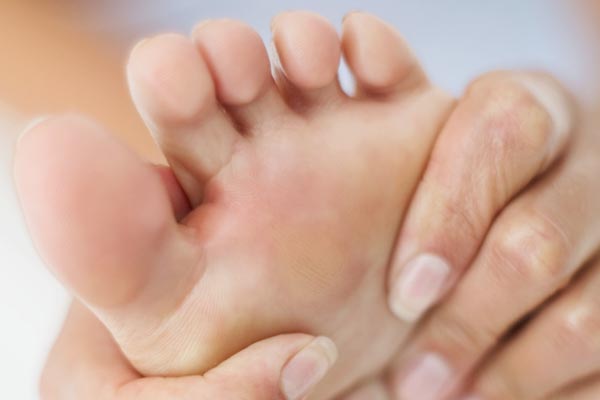Fibromyalgia and Electric Shock Sensation
Fibromyalgia is a very common disorder characterized by severe widespread or localized pain. Permanent cure of this disease is not available till date.
The American College of Rheumatology proposed 11 of 18 tender points. Over 90% of people diagnosed with fibromyalgia experience severe muscular pain, fatigue, stress, disturbed sleep and stiffness in legs. Other reported symptoms are irritable bowel syndrome (IBS), joint pain, depression, etc.
The causes of fibromyalgia are still not clear. Organs involved in the disease is a mystery to date. Thus, no tests to confirm the disease is available.
There are no definite laboratory tests to diagnose fibromyalgia. Thus, it is very difficult to diagnose fibromyalgia.
The word fibromyalgia is made up of three words: “fibro” which means fiber-like, “mya” which means muscle and “algia” that means pain.
With the worldwide researchers on fibromyalgia, people are becoming more and more knowledgeable.
Many researchers link fibromyalgia to genetics, food sensitivities, poor digestion, neurotransmitter deficiencies, rheumatoid arthritis, stress, etc.
Risk of developing fibromyalgia increases if there is any family history of the disease, being female, suffering from a migraine or rheumatoid arthritis, etc.
Fibromyalgia might flare up due to physical and mental trauma, stress, anxiety, depression, etc.
Severe pain leads to abnormal pain perception in the brain which is called as central sensitization.
What are the Symptoms Associated with Fibromyalgia?
Fibromyalgia is made up of a combination of two and more symptoms. The most common symptom is widespread pain all over the body or at some distinct points called as tender points.
Tender points include the neck, chest, buttocks, hip, shoulder, arms, legs, etc. Some of the common symptoms of fibromyalgia are chronic pain, anxiety, fatigue, disturbed sleep, depression, poor memory, etc.
Researchers estimated that 2%-3% of Americans are affected by fibromyalgia. Prevalence of the disease is more in women than men.
It has been reported that women in her 80s experience fewer activities in daily routine on an average.
Women suffering from fibromyalgia have been reported with depression, distress, and chronic illness. Fibromyalgia affects the quality of life of the patient. Women are more prone to chronic pain conditions and disorders.
Fibromyalgia pain can last for more than three months sometimes for years and even decades. Men are less likely to report chronic pain than women but this does not mean that men do not experience pain.
Men also experience pain like women but the intensity, severity, and occurrence of pain is more in women than men.
Sometimes it is difficult to distinguish between fibromyalgia and other chronic pain diseases. The chronic pain in fibromyalgia is not always limited to the tender points but is widespread all over the body.
Many theories suggest that stimuli of pain are caused by the abnormal processing in the central nervous system (CNS) such as spinal cord and brain.
Other studies relate hormonal disbalance to be a cause of fibromyalgia pain. The decrease in the serotonin and tryptophan levels are known to alter the levels of norepinephrine.

What are the primary symptoms of fibromyalgia?
When a patient is diagnosed with an illness or condition, understanding symptoms can help the patient manage the diagnosis. The more patients learn about symptoms, the better they understand the condition itself so that those symptoms can be managed.
According to the National Fibromyalgia & Chronic Pain Association, the two most well-known symptoms of fibromyalgia are widespread body pain and fatigue.
Along with widespread pain, patients have a number of tender points throughout the body. Tender points are sometimes referred to as trigger points. These tender points can be used to diagnose fibromyalgia, along with additional patient information.
The tender points can be found at the base of the head, the neck, shoulders, elbows, knees, wrists, ankles, back, and hips. Not all patients experience pain at all of these points or simultaneously. Pain may move throughout the body.
What is the electric shock sensation fibromyalgia patients experience?
Fibromyalgia is a chronic pain disorder that is highly complex and often difficult to diagnose. Many people experience symptoms for years before they reach a diagnosis. The cause of fibromyalgia is not currently known. However, multiple theories have been developed by researchers and scientists.
Though fibromyalgia is not an autoimmune disorder, patients may experience flares in pain and fatigue based on external and internal triggers. These triggers include stress, illness, long-distance travel, exertion, heat, and cold, among others.
Pain and fatigue are the most common symptoms of fibromyalgia. Pain can be sharp or dull, ongoing or intermittent, and can vary in intensity.
Some patients may experience pain so severe that it impairs mobility. Other patients may manage pain without medication. It is in the symptom of pain that the electric shock sensation is experienced.
Though pain and fatigue are the primary symptoms of fibromyalgia, they are certainly not the only symptoms. According to the Mayo Clinic, another common symptom of fibromyalgia is a cognitive difficulty, referred to as “fibro fog.” The cognitive difficulty is often attributed to the pain and fatigue.
According to the FibroCenter, additional symptoms associated with fibromyalgia include anxiety and depression, abdominal pain, headaches, and gastrointestinal problems, among others.
These symptoms vary significantly based on the individual patient. These symptoms may also be influenced by other disorders the patient has developed.
The pain experienced by fibromyalgia patients may take many forms and intensities. Since the condition may be caused by the way nerves react to stimuli, patients will describe the pain differently. Some people describe their pain sensation as something like an electric shock.
The electric shock sensation patients experience may be in one small area of the body, such as a trigger point. It may also be through the entire body at once. As with most symptoms, it depends on the severity of the condition and the patient’s pain threshold.
What causes the electric shock sensation in the body?
Because of the involvement of the nerves, the American College of Rheumatology considers fibromyalgia a neurological health problem. Because of the way fibromyalgia impacts the body, it is often diagnosed and treated by a rheumatologist.
In addition, it may be that the electric shock sensation is caused because of the involvement of the nerves. However, this cannot be known for sure.
Since the cause of fibromyalgia is not fully known, the cause of the electric shock sensation is not fully known, either.
Some medical experts think fibromyalgia is caused by hormone or chemical imbalances that affect the way the nerves respond to stimuli. If that is the case, the electric shock sensation would be caused by the nerves misfiring or misinterpreting stimuli.
Other medical experts think fibromyalgia is the body’s reaction to trauma, such as abuse. If that is the case, the electric shock sensation would be caused by the nerves reacting to emotional stimuli, such as the body’s fear of a person or situation.
What does the electric shock sensation feel like?
Just as there are different types of electric shocks that occur, the sensations experienced by fibromyalgia patients vary significantly.
Some patients may experience a “pins and needles” feeling in their hands and/or feet. Other patients may experience a sudden, severe, sharp pain shooting through the body, seemingly to the bone.
It is most common for these electric shock sensations to come on suddenly and to be severe in comparison to other pain sensations. Though the initial “jolt” of pain often dissipates quickly, the pain can still be felt afterward.
This also happens when someone experiences an electric shock, which contributes to the comparison of an electric shock to the fibromyalgia symptom.
What can patients do about the electric shock sensation?
There is no single diagnostic test for fibromyalgia at this time. Instead, it is diagnosed through a combination of a patient’s medical history, symptoms, and excluding other conditions.
Since that is the case, diagnosis can be difficult. Some patients are misdiagnosed or do not get a diagnosis for a long time.
Because of this, patients experience symptoms for a long time without the proper treatment support. To manage the electric shock sensations without medication, patients can use stress-relief techniques to ease the pain, do a gentle exercise like yoga, or get massages to help relax the muscles and perhaps prevent the electric shock sensation from occurring.
According to the U.S. National Library of Medicine, there is no cure for fibromyalgia at this time. Treatments focus on easing symptoms so patients can live as full a life as possible.
This typically includes pain-relieving medication as well as medications for other prominent symptoms experienced by the patient. If left untreated, fibromyalgia may get worse for patients over time.
Since there is no cure for fibromyalgia, it is likely that there is little that can be done to prevent these sensations.
However, through proper treatment and pain management, this symptom may be less likely to occur. That can help the patient live a healthier, happier life with minimal pain sensations.
Does Fibromyalgia Causes Electric Shock Sensations?
Yes, fibromyalgia sufferer can experience electric shock sensation and pins and needles like sensation in hands and feet. Electric shock sensation can be experienced anywhere and anytime.
It can last for several days, weeks or even months. It can happen when a fibromyalgia patient gets up from the chair after sitting for too long. It can be a feeling like someone is poking a pin or needle in various parts of the body.
Fibromyalgia is itself a very frustrating and painful disease and its symptoms are too depressing.
Fibromyalgia along with electric shock sensation can be very wired as the shocks might produce sudden jerks and twitches in the body. It may lead to disturbed sleep or poor sleep patterns.
Numbness and tingling sensation in the limbs is also referred to as paresthesia. It can be due to peripheral disturbances in the nerve pathways.
People suffering from fibromyalgia are also known to have peripheral neuropathy. In this condition, tingling sensation is experienced mostly in legs and pins and needles in the legs or arms. It may be caused due to the hyper-arousal state of the central nervous system.
Paresthesia is often confused with a symptom of s stroke. Anyone suffering from this symptom should seek medical help.
This condition is more often observed in people suffering from diabetes. This is not so common symptoms of fibromyalgia but does occur with fibromyalgia too.
Sometimes, the electric shock sensation can be painful too. Some researchers believe that paresthesia can be a cause of over stimulation of the central nervous system that leads to over sensitivity throughout the body parts. This can cause severe pain accompanied by extreme sensitivity to touch.
Another reason for electric shock sensation can be muscle inflammation that compresses nerves. Anxiety can also flare up electric shock sensation.
What Kind of Sensation Can You Experience?
Electric shock sensation is a feeling that might feel like an electric shock traveling throughout the body. The patient might also experience pins and needle-like severe pain.
The tingling sensation can also be found in the flash of light coming and going. Jerks in joints of arms, legs, fingers, and toes can also be felt.
Facial twitching can also occur in mouth, eyes, and eyebrows. Crawling sensation in the skin can also be felt.
It can occur in any part of the body especially in the legs and arms. It can occur randomly without any hints.
Some physicians relate widespread itching and sensory loss to small fiber polyneuropathy (SFPN). In this condition, there is a disturbance in the sensation of the skin.
The sufferer feels like an electric shock running throughout the body like pain or cold like pain.
Some sufferer also experiences uncomfortable and painful feeling even when touched. This is referred as allodynia, a rare symptom of fibromyalgia.
Is There Any Treatment Available for Electric Shock Sensation?
Treatment is available to minimize the symptoms of fibromyalgia but 100% cure of this disease is not available till date.
One of the most effective treatments for fibromyalgia can be several changes in the lifestyle followed by medications as prescribed by the physician.
Anti-depressants and anti-anxiety medications can give relief to the fibromyalgia sufferer.
Physical Therapy
Many sufferers of fibromyalgia have been positively affected by physical therapy. It is an alternative treatment method that does not involve the use of any medication. It is also suitable for people with a chronic pain problem.
With the help of a physical therapist, the sufferer can plan his/her own physical activity program that is right for the sufferer.
In case of severe pain, the physical activity should not be stopped as it can give relief after a period of time.
Following are the types of physical activities that a fibromyalgia sufferer should follow:
1- Some sufferers might get relief from the hot water bath, heating pads or high-frequency sound waves while others might feel relieved by a cold treatment like the use of ice packs, taking an ice bath and ice massage, etc.
2- Vibration therapy is a kind of physical therapy where a probe is applied to a body part with moderate pressure and vibrated several thousand times per second.
Vibration therapy involves the use of low electrical currents by placing fine needles placed at specific body parts. An example of vibration therapy is acupuncture.
Acupuncture is seen to interfere with the brain by sending pain signals to the brain. This might cause a release of natural painkillers called endorphins.
Acupuncture improves stiffness in people suffering from fibromyalgia. It is also known to reduce pain and fatigue and also to improve sleep. It is better that non-acupuncture treatment in reducing pain and fatigue.
Acupuncture along with electrical stimulation has proved to reduce pain and stiffness, sleep and overall well-being of an individual.
In various researchers, it has been found that acupuncture with electrical stimulation is better than one without electrical stimulation.
Acupuncture without electrical stimulation is not that effective in reducing pain and fatigue. Acupuncture is known to enhance the effect of drugs and exercise and pain.
Exercise
Exercise has always proved to enhance the daily activity of a normal person. Fibromyalgia sufferers also equally benefitted by exercises.
Exercise includes physical movement, stretching, simple aerobic exercises, walking, and yoga to name a few.
It strengthens muscles and reduces body stress and fatigue. Regular exercising helps in combating anxiety and depression.
Change in Diet
Lifestyle change must always be accompanied by changes in diet. Changes in diet can help in reducing the symptoms of fibromyalgia.
Some researchers have suggested that changing eating habits to a clean and healthy eating can help in lessening the symptoms of fibromyalgia.
Eliminating dairy and gluten from the diet can be beneficial. Some food might be allergic and inflammatory reactions and food allergies. Eating such food can also flare up the symptoms of fibromyalgia.
Thus, eating a healthy diet, exercising regularly and opting for any physical therapies can help in reducing electric shock sensation.
Healthy eating also helps in keeping a healthy body weight. Exercise and physical therapies can help in maintaining a healthy well-being of a fibromyalgia sufferer.






Thank you so much for this article because i have been having electric shock like symptoms in my feet and half way up my legs and it is so painful that i cry out loud.I have suffered with fybromyalgia for 30 years and i didn,t realize that the pain in my feet was caused by fibro and it had my doctor stumped.
I have been getting the electric shock pains a lot recently. Thought it may have been because of my central sensitization or something else
I have central sensitization and have been getting the electric shock pains a lot recently.
Raylee,
I, too, am a very long time Fibro Pain Warrior. I developed what was diagnosed as Neuropathy or Parathesia in both of my feet following thyroid surgery in December 2012. The doctors want to argue who’s at fault, the surgeon says it’s the Fibro. No, it’s not the Fibro Dr. because it was a result of nerve damage during the surgery. Nevertheless, the result is two extremely painful feet now 4 1/2 years later. I have done all that can be done medically, Gabapentin followed by Lyrica which I am still on and even tried a RX call Metanx. If that is new for you, simply Google and you will find it easily. It is a pharmaceutical grade of multiple B vitamins which has evidence-based research for treatment of. Though it did not work for me, I have read countless stories of those it did. I am having the best response now about 7 weeks since I started using CBD Oil. It eliminates those painful sensations at the correct dosage which takes trial and painful electrical shocks and what I described as the cramping toe feeling. Untreated Neuropathy will continue to do more damage to the nerves and generally can go into Stocking-glove disorder. It will move from the outer Limbs and my case hands and feet up through into the calves and forearms.